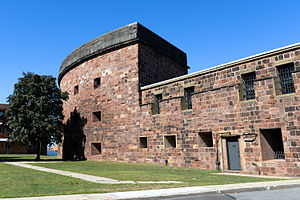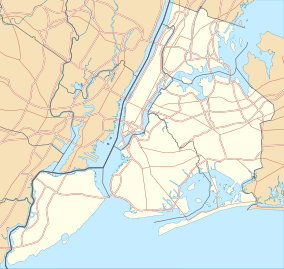Governors Island National Monument is a unit of the United States national park system in New York City. It is located on 22 acres (89,000 m2) of Governors Island, a 172-acre (0.70 km2) island located off the southern tip of Manhattan Island, at the confluence of the Hudson and East rivers in New York Harbor.
| Governors Island National Monument | |
|---|---|
 | |
| Location | New York City, New York |
| Coordinates | 40°41′29″N 74°0′58″W / 40.69139°N 74.01611°W |
| Area | 22.78 acres (9.22 ha)[1] |
| Created | January 19, 2001 |
| Visitors | 402,174 (in 2011)[2] |
| Governing body | National Park Service |
| Website | Governors Island National Monument |
Conversion to public use
editIn October 1995 the United States Coast Guard announced it would close its largest base, at Governors Island, as a cost savings measure.[3][4] The Coast Guard had established the base on the island in 1966 after the U.S. Army closed Fort Jay, an Army post since 1794.[5][6]
In 1996, the Coast Guard closed the base and conveyed it as surplus property to the federal government's General Services Administration for disposal through transfer or sale. The closure was at the initiative of the Coast Guard, then a bureau of the U.S. Department of Transportation, which was seeking to close a $400 million budget gap. The closure of the base represented an estimated 30 million dollar savings. Since the closure was an initiated action by the Coast Guard, it was not subject to the Base Realignment and Closure process.[7]
At the time of the closure announcement in October 1995, President Bill Clinton and New York Senator Daniel Patrick Moynihan reached an informal agreement to convey the island to the city and state of New York for $1, if a plan for public benefit could be developed.[8] The city was initially reluctant to take up Clinton's offer because it would not have been financially beneficial to the city.[9] The issue was exacerbated when the United States Congress passed the Balanced Budget Act in August 1997, stipulating that the GSA sell the island at a fair market value by 2002.[10][11] The island's sale was expected to net the federal government $500 million.[12]
Establishment of the monument
editAs President Clinton left office in January 2001, with no resolution of the island's future in hand, and at the urging of members of the New York congressional delegation, he established a Governors Island National Monument by Presidential Proclamation 7402 of January 19, 2001.[13] The proclamation did not fully establish the boundaries of the monument, but did set forth the federal intention of preserving the fortifications, Fort Jay and Castle Williams, the oldest and most historic features on the island.[14] The Justice Department under President George W. Bush concluded the proclamation possessed technical errors, but did not revoke or invalidate the proclamation.
In an April 2002 White House meeting with city and state officials, President Bush announced his intention to sell the island to the city and state of New York. While the White House intended the transaction to be concluded by September 2002, it took several months of negotiations with city, state and federal officials to resolve outstanding issues.
On January 31, 2003, the island was conveyed to an intermediary, the National Trust for Historic Preservation, which attached restrictive land use covenants to the deed, then conveyed the island to two parties: 22 acres (89,000 m2) was conveyed to the U.S. Department of the Interior for use as a national monument; and 150 acres (0.61 km2) went to the Governors Island Preservation and Education Corporation, formed jointly by the State and City of New York – now The Trust for Governors Island, an instrumentality of the City of New York – for the purpose of administering and redeveloping the island. Presidential Proclamation 7647 of February 7, 2003 formally re-affirmed the establishment of the national monument.[15][16]
Significance
editBoth presidential proclamations noted that the island served as an outpost to protect New York City from sea attack. Between 1806 and 1811, Castle Williams and Fort Jay were constructed as part of the First and Second American System of Coastal Fortification; they played important roles in the War of 1812, the Civil War, and World Wars I and II.[6]
The fortifications were built on the most strategic defensive positions on the island. Fort Jay, first constructed in the 1790s and reconstructed between 1806 and 1809, is on the highest point of the island. The surrounding open space or glacis slopes down to the waterfront on all sides. Castle Williams, started in 1807 and completed in November 1811, occupies a rocky shoal that extended into the harbor channel at the northwest corner of the island and served as the most important strategic defensive point in the upper bay of New York Harbor.[6]
By the 1830s, the protective functions of both fortifications had diminished, but the core of a small urban Army post evolved around them. By the 1870s, with deep reductions in a post-Civil War army, the post became a major headquarters for the U.S. Army, a role it played until their departure in 1966. The residential and institutional structures surrounding the two fortifications are now part of the Governors Island National Historic Landmark District, containing over 60 structures related to two centuries of the military history of the nation.[6]
Since the island was managed by the United States Army and the United States Coast Guard for nearly 200 years, and was no longer required for defense or Coast Guard purposes, the establishment of the monument provided an excellent opportunity for the public to observe and understand the harbor history, its defense and its ecology.[6]
The island and monument has been open on a seasonal basis during the summer months since 2005.[17][18][19] The island became more popular over the years, attracting 275,000 visitors in 2009[20] and 800,000 visitors in 2018.[17]
See also
editReferences
editNotes
- ^ "Listing of acreage – December 31, 2011" (XLSX). Land Resource Division, National Park Service. Retrieved May 14, 2012. (National Park Service Acreage Reports)
- ^ "NPS Annual Recreation Visits Report". National Park Service. Retrieved May 14, 2012.
- ^ "COAST GUARD PLANS TO CUT 1,400 JOBS". Washington Post. October 18, 1995. ISSN 0190-8286. Retrieved May 24, 2019.
- ^ Kennedy, Randy (October 18, 1995). "On an Oasis in New York Harbor, a Bittersweet Salute". The New York Times. ISSN 0362-4331. Retrieved May 24, 2019.
- ^ Johnston, Richard J.h. (January 1, 1966). "A 15-Gun Salute Signals the Army's Departure From Governors Island; FIRST ARMY SAYS FAREWELL TO CITY Program Marks End of Era at Fort Jay as Coast Guard Prepares to Move In". The New York Times. Retrieved May 15, 2019.
- ^ a b c d e "A Brief History of Governors Island". Governors Island National Monument (U.S. National Park Service). January 5, 2015. Retrieved November 19, 2015.
- ^ Dunlap, David W. (November 12, 1995). "Islands Lapped by Tides of Change". The New York Times. ISSN 0362-4331. Retrieved May 24, 2019.
- ^ Lueck, Thomas J. (March 27, 1997). "Clinton Offer of Island to New York Is Stalled". The New York Times. ISSN 0362-4331. Retrieved May 24, 2019.
- ^ Allen, Michael O. (June 14, 1998). "Govs Isle no bargain, city sez". New York Daily News. p. 34. Retrieved May 24, 2019 – via newspapers.com .
- ^ Kasich, John R. (August 5, 1997). "H.R.2015 – 105th Congress (1997–1998): Balanced Budget Act of 1997". www.congress.gov. Retrieved May 24, 2019.
- ^ Stewart, Barbara (August 25, 2001). "As Deadline Draws Near, the Future of Governors Island Remains Uncertain". The New York Times. ISSN 0362-4331. Retrieved May 24, 2019.
- ^ Dao, James (March 20, 1999). "Looking for a Quick $500 Million From Governors Island". The New York Times. ISSN 0362-4331. Retrieved May 24, 2019.
- ^ "Establishment of the Governors Island National Monument" (January 20, 2001)
- ^ Hernandez, Raymond; Stewart, Barbara (January 21, 2001). "Clinton, With Time Running Out, Protects Part of Governors Island". The New York Times. ISSN 0362-4331. Retrieved May 24, 2019.
- ^ Pristin, Terry (January 31, 2003). "White House to Hand Over Governors Island to New York". The New York Times. ISSN 0362-4331. Retrieved May 24, 2019.
- ^ Barrett, Devlin (February 1, 2003). "New York Reclaims Governors Island". Elmira, NY: Star-Gazette. Associated Press. p. 27. Retrieved May 24, 2019 – via newspapers.com .
- ^ a b Stapinski, Helene (September 28, 2018). "Is This the End of Governors Island?". The New York Times. ISSN 0362-4331. Retrieved May 30, 2019.
- ^ Rubinstein, Dana (July 25, 2013). "Google CEO Eric Schmidt underwrites hills on Governors Island". Politico PRO. Retrieved May 30, 2019.
- ^ Taylor, Kate (May 29, 2008). "A New Arts Scene on Governors Island". The New York Sun. Retrieved May 30, 2019.
- ^ Jurgensen, John (July 24, 2010). "Governors Island Is Ready to Rock". Wall Street Journal. ISSN 0099-9660. Retrieved May 30, 2019.
Bibliography
- "Statement on the Transfer of Governors Island" (January 31, 2003]
- "Establishment of the Governors Island National Monument" (February 7, 2003)
- "Governors Island National Monument" on the National Park Service website
External links
edit- Governors Island National Monument – official site
- The Trust for Governors Island


